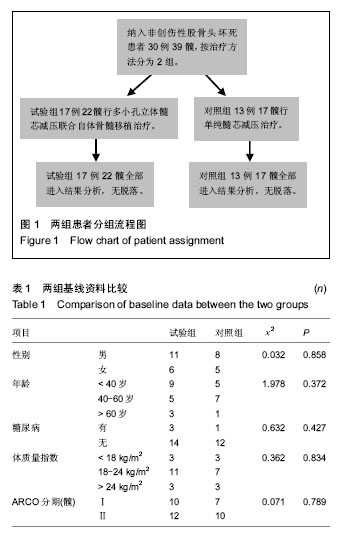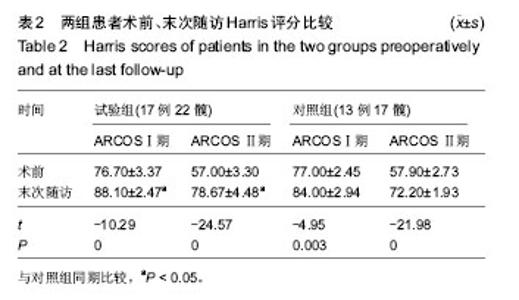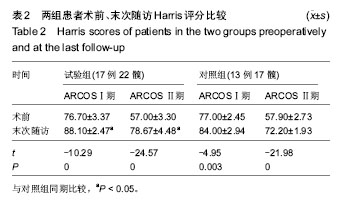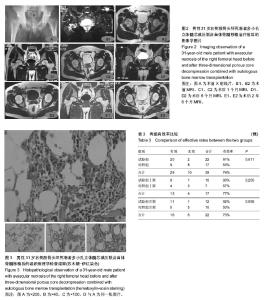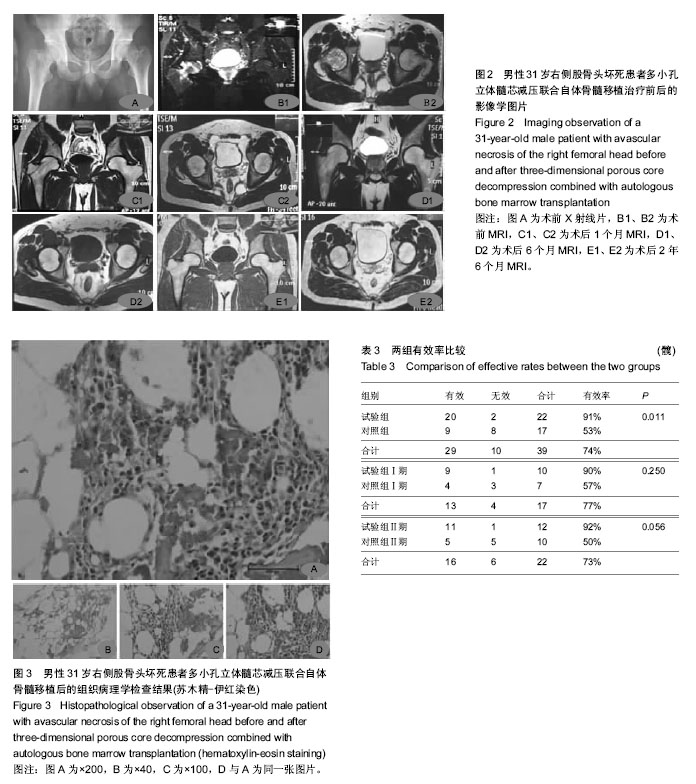| [1] Kaushik AP, Das A, Cui Q. Osteonecrosis of the femoral head: An update in year 2012. World J Orthop. 2012; 3:49-57.[2] Harris WH. Traumatic arthritis of the hip after dislocation and acetabular fractures: treatment by mold arthroplasty. An end-result study using a new method of result evaluation. J Bone Joint Surg Am. 1969; 51:737-755.[3] Jones LC, Hungerford DS. The pathogenesis of osteonecrosis. Instr Course Lect. 2007; 56:179-196.[4] Miller KD, Masur H, Jones EC, et al. High prevalence of osteonecrosis of the femoral head in HIV-infected adults. Ann Intern Med. 2002; 137:17-25.[5] 孙泓泓,李艳捧,李兴华,等.股骨头坏死塌陷前期髋关节软骨的MRI研究[J]. 实用放射学杂志,2013, 29(11):1818-1822.[6] Lieberman JR, Berry DJ, Mont MA, et al. Osteonecrosis of the hip: management in the 21st century. Instr Course Lect. 2003; 52:337-355.[7] 张洋,王楠,杨立枫,等.骨髓间充质干细胞移植联合髓芯减压植骨修复股骨头坏死[J].中国组织工程研究,2015,19(6):883-890.[8] 张帆,司文腾,王跃辉,等.骨髓干细胞移植治疗股骨头坏死疗效分析[J].中国实用医药,2016,11(9):73-74.[9] Varitimidis SE, Dimitroulias AP, Karachalios TS, et al. Outcome after tantalum rod implantation for treatment of femoral head osteonecrosis: 26 hips followed for an average of 3 years. Acta Orthop. 2009; 80:20-25.[10] 吴刚,张永峰.复合自体骨髓的骨诱导材料结合髓芯减压钛棒支撑修复Ⅱ期股骨头坏死[J].中国组织工程研究,2015,19(28): 4460-4464.[11] 尚咏,虞攀峰,赵旭红,等.髓芯减压钽棒+自体骨植入治疗成人早期股骨头缺血性坏死的短期疗效观察[J].山西医科大学学报, 2013,44(3):240-244.[12] 吴敏,官建中,肖玉周,等.多孔钽棒置入联合髓芯减压治疗成人早期股骨头坏死近期疗效观察[J].蚌埠医学院学报,2014,39(5): 590-592.[13] 张琦,王雨,王爱民.钽棒植入治疗早期股骨头坏死短期临床疗效观察[J]. 第三军医大学学报,2013,35(10):1027-1029.[14] 毛子木,尹崑,王宇泽,等.钽棒置入治疗股骨头坏死的疗效分析及预后模型建立[J].中国组织工程研究,2016,20(47):7043-7050.[15] 张怡元,冯尔宥,陈日齐,等.多孔钽块置入治疗股骨头缺血性坏死的生物力学及三维有限元分析[J]. 中国矫形外科杂志,2012, 20(12):1113-1116.[16] 于志亮,张宇,杨义,等.带旋髂深血管蒂髂骨瓣及松质骨移植治疗成人股骨头缺血性坏死[J].中国修复重建外科杂志,2013, 27(7): 860-863.[17] 赵德伟,谢辉,王本杰,等.带血管蒂髂骨瓣转移联合多孔钽金属棒植入治疗股骨头缺血性坏死[J].中华显微外科杂志,2014,37(1): 29-34.[18] 王德峰,张喜善,武京国,等.自体外周血单核细胞移植联合多孔髓芯减压修复股骨头坏死:11个月随访评价[J].中国组织工程研究, 2015,19(1):114-118.[19] 冯宾,钱文伟,翁习生,等.髓芯减压+同种异体骨打压植骨治疗早期股骨头坏死的疗效观察[J].中国医学科学院学报,2015, 37(2): 133-139.[20] 陈黔,邱冰,王大寿,等.髓芯减压结合硫酸钙人工骨植入治疗股骨头缺血坏死48例分析[J].重庆医学,2015, 44(26):3679-3681, 3682.[21] Ficat RP. Idiopathic bone necrosis of the femoral head. Early diagnosis and treatment. J Bone Joint Surg Br. 1985; 67:3-9.[22] Nickel C, Kettler C, Muehlbacher M, et al. Effect of progressive muscle relaxation in adolescent female bronchial asthma patients: a randomized, double-blind, controlled study. J Psychosom Res. 2005;59:393-398.[23] Mont MA, Carbone JJ, Fairbank AC. Core decompression versus nonoperative management for osteonecrosis of the hip. Clin Orthop Relat Res. 1996:169-178.[24] Miao H, Ye D, Liang W, et al. Effect of Osteonecrosis Intervention Rod Versus Core Decompression Using Multiple Small Drill Holes on Early Stages of Necrosis of the Femoral Head: A Prospective Study on a Series of 60 Patients with a Minimum 1-Year-Follow-Up. Open Orthop J. 2015; 9:179-184.[25] Mont MA, Zywiel MG, Marker DR, et al. The natural history of untreated asymptomatic osteonecrosis of the femoral head: a systematic literature review. J Bone Joint Surg Am. 2010; 92: 2165-2170.[26] Kang P, Pei F, Shen B, et al. Are the results of multiple drilling and alendronate for osteonecrosis of the femoral head better than those of multiple drilling? A pilot study. Joint Bone Spine. 2012; 79:67-72.[27] Floerkemeier T, Lutz A, Nackenhorst U, et al. Core decompression and osteonecrosis intervention rod in osteonecrosis of the femoral head: clinical outcome and finite element analysis. Int Orthop. 2011; 35:1461-1466.[28] Hernigou P, Poignard A, Zilber S, et al. Cell therapy of hip osteonecrosis with autologous bone marrow grafting. Indian J Orthop. 2009; 43:40-45.[29] Gangji V, Hauzeur JP, Matos C, et al. Treatment of osteonecrosis of the femoral head with implantation of autologous bone-marrow cells. A pilot study. J Bone Joint Surg Am. 2004; 86-A:1153-1160.[30] Gangji V, De Maertelaer V, Hauzeur JP. Autologous bone marrow cell implantation in the treatment of non-traumatic osteonecrosis of the femoral head: Five year follow-up of a prospective controlled study. Bone. 2011; 49:1005-1009. |

